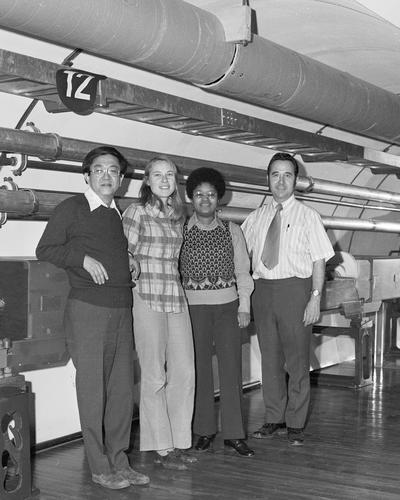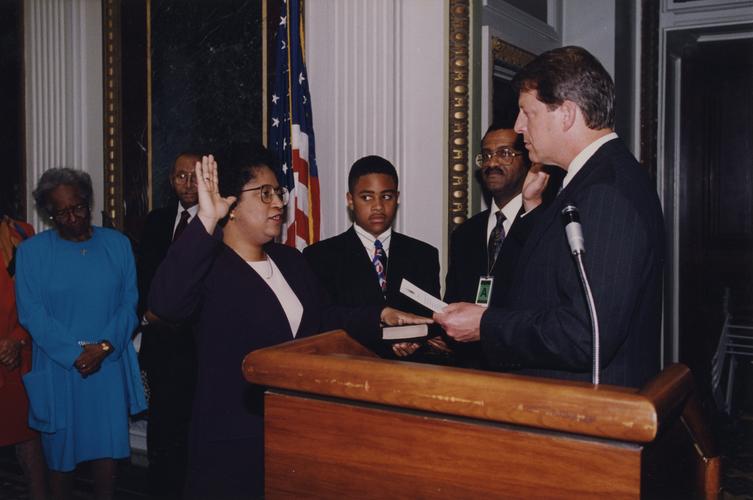Breaking through to make scientific and civic progress.

Shirley Ann Jackson has broken many barriers for Black women physicists; as the first Black woman to earn a PhD from MIT and the second Black woman in the United States to earn a PhD in physics, she is a trailblazer. From her research on elementary particle physics and condensed matter, to her current position as president of Rensselaer Polytechnic Institute, Shirley Ann Jackson has had a remarkable, brilliant career.
"Throughout her long career in academic and civic service, Dr. Jackson has been a trailblazer. In every role she held, Dr. Jackson stood at the edge of what was known-- what was expected-- then pushed right through."
Learn more by watching the video, or continue reading below!
Dr. Jackson's Education
Dr. Jackson was born in 1946 in Washington, DC. She credits her parents for fostering her love of science by valuing her education and helping her with school science projects. After graduating from high school, Dr. Jackson began her degree in physics at MIT as one of only twenty Black students in her class, and the only Black theoretical physicist.
Dr. Jackson eventually earned her PhD in physics from MIT. She was the second African American woman to earn a PhD in physics ever, just one year after Willie Hobbs Moore earned her PhD from the University of Michigan. This also made Dr. Jackson the first Black woman to earn a PhD from MIT, in any field. After graduating, Dr. Jackson continued to study particle physics at famous labs such as Fermilab, SLAC, and CERN.
The Universe's Building Blocks
Particle physics is our way of understanding the most fundamental building blocks that make up the Universe. We classify these building blocks, known as particles, based on their charge and how massive they are. We call this theory the Standard Model and it has three main types of particles: quarks, leptons, and bosons.

Quarks can only exist when they’re bound to other quarks creating larger particles; you would never find a single quark on its own, but you can find three quarks inside of a proton.


Leptons on the other hand, can exist on their own, for example the most famous lepton, the electron.

Finally, bosons are particles that carry forces and let particles interact with each other. For example, the photon carries the electromagnetic force, which gives us light!
In her work, Dr. Jackson studied interactions between hadrons, particles that are made up of two or more quarks.

To study these particles, we collide them with one another at very high speeds so that they break apart and form other particles.

This allows scientists to learn about particles that can’t exist on their own, like quarks! Dr. Jackson worked on methods to predict what would happen in these collisions so other physicists knew what to look for.
Electrons as Waves
In 1976, Dr. Jackson became a professor at Rutgers University and started working at a laboratory called Bell Labs.

"Dr. Jackson worked on understanding the behavior of charge density waves, which is crucial for building semiconductors."
There, her work took a different direction: condensed matter physics, the study of how electrons behave within materials.


In solids, atoms are arranged in crystals.
Each atom has a nucleus with protons and neutrons, and is surrounded by electrons.


If the material is able to conduct electricity, the electrons will flow through the material creating an electric current.
Electrons aren't just particles though, they are also waves. This is called wave-particle duality.
When you place two kinds of materials next to each other, the electrons can no longer flow easily between the two materials. Instead, they form waves, known as charge density waves.

Dr. Jackson worked on understanding the behavior of these charge density waves, which is crucial for building semiconductors. Semiconductors are widely used in most modern electronics, like your computer or phone!
Pushing the Boundaries
Beyond her scientific research, Dr. Jackson has also worked on the role of science and technology in public policy. Because of her achievements in physics, she was appointed Chairman of the US Nuclear Regulatory Commission by President Bill Clinton in 1995, to oversee how the United States can safely handle nuclear physics research and development. She was both the first Black person and the first woman to hold that position.
Since 1999, Dr. Jackson has been the president of Rensselaer Polytechnic Institute, a research university. Yet again, she was the first Black person and the first woman to hold this position. In 2016, Dr. Shirley Ann Jackson received the National Medal of Science, a prestigious award in recognition for her many important contributions to the sciences.
Throughout her long career in academic and civic service, Dr. Jackson has been a trailblazer. In every role she held, Dr. Jackson stood at the edge of what was known-- what was expected-- then pushed right through. Her research on tiny particles, both in particle and condensed matter physics, has had a truly huge impact!
Photos courtesy of MIT Museum, Rensselaer Polytechnic Institute, and the National Science & Technology Medals Foundation
Written by Ashley Cavanagh
Edited by Weilu Shen, Madelyn Leembruggen
Portrait by Ashley Cavanagh
Cartoons by Madelyn Leembruggen
Primary sources and additional reading:
"Physicists of the African Diaspora: Shirley A. Jackson" from the University of Buffalo Department of Math
"President Shirley Ann Jackson Named Recipient of National Medal of Science" from Rensselaer Polytechnic Institute
2006 Interview with Shirley Ann Jackson
Learn more about Dr. Shirley Ann Jackson's discoveries!
Investigate (1-2 hours): Learn more about the tiny particles in the Standard Model with The Particle Adventure. Click through the slides to learn about the matter and forces that make up our universe.
Expand (30-60 minutes): Dr. Jackson studied the fundamental building blocks of our universe by smashing particles together at an accelerator. Read how a particle accelerator works. Then take a virtual tour of the world's largest accelerator facility, CERN.
Define (1-2 hours): Learn about semiconductors and why they're so important. Start with these resources, then try to find more sources on your own.















